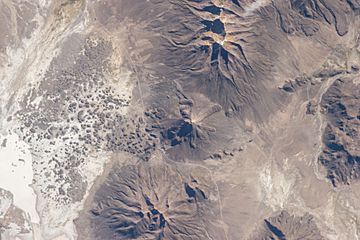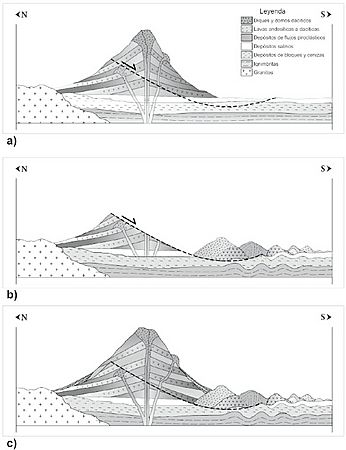Tata Sabaya facts for kids
Quick facts for kids Tata Sabaya |
|
|---|---|
 |
|
| Highest point | |
| Elevation | 5,430 m (17,810 ft) |
| Geography | |
|
Lua error in Module:Location_map at line 420: attempt to index field 'wikibase' (a nil value).
|
|
Tata Sabaya is a tall volcano in Bolivia, standing at 5,430 meters (about 17,815 feet) high. It is part of the Central Volcanic Zone, which is a chain of volcanoes in the Andes mountains. This area has been active with volcanoes for a very long time, even since the Jurassic period.
Tata Sabaya is located in a quiet area, north of a large salt flat called the Salar de Coipasa. The volcano formed because the Nazca Plate (a huge piece of the Earth's crust) is slowly sliding under the South American Plate. This process, called subduction, creates volcanoes. Tata Sabaya sits on a special line in the Earth's crust where older rock meets younger rock.
About 12,000 years ago, a big part of Tata Sabaya's southern side broke off and slid down. This huge landslide went into a lake that covered the Salar de Coipasa at that time. Later, new lava flows and lava domes filled in the scar left by the landslide. One eruption happened around 6,000 years ago.
Contents
Exploring Tata Sabaya: Location and Shape
Tata Sabaya is found just north of the Salar de Coipasa salt flat in Bolivia. A small village called Pagador is located to the west, but the whole region does not have many people living there. The name "Tata Sabaya" means "Father Sabaya." The word "Sabaya" might come from an old local word for "devil" or "demon." People in the area have many myths and stories about the volcano, sometimes seeing it as a living being.
Part of the Andes Volcano Chain
Tata Sabaya is one of many volcanoes in the Central Volcanic Zone of the Andes. This zone forms a long line of volcanoes, mostly following the Western Cordillera mountain range. There are about 44 volcanoes in this area that have been active in the last 10,000 years (the Holocene period). Because the area is so remote and dry, scientists have not studied all of them closely. Some well-known volcanoes nearby include Lastarria and Ollagüe.
How Tata Sabaya Looks
Tata Sabaya is a tall volcano, reaching 5,430 meters (17,815 feet) high. Five lava flows stretch out from its top towards the north. These flows can be up to 2 kilometers (1.2 miles) long. The top of these lava flows has a large scar from where part of the volcano collapsed. This scar is like a cliff, up to 50 meters (164 feet) high. Newer lava flows have partly filled this space. Farther away from the volcano, the scar is even bigger, reaching about 200 meters (656 feet) high on the southeastern side.
A huge area of land, about 300 square kilometers (116 square miles), south of the volcano is covered by a landslide deposit. This deposit stretches for 20 kilometers (12 miles) long and 7 kilometers (4.3 miles) wide. It has a volume of about 6 cubic kilometers (1.4 cubic miles). This landslide included material from the salt flat. It is so big that scientists could even see it on old satellite images. The deposit is made of many small hills, called hummocks, which get smaller the farther they are from the volcano. This landslide material extends into the Salar de Coipasa, where it is partly covered by lake sediments.
Understanding Tata Sabaya's Geology
The volcanoes in the Andean Volcanic Belt are formed because the Nazca Plate is sliding under the South America Plate. This happens at a speed of about 10 centimeters (4 inches) per year. This process creates molten rock, called magma, which then rises to form volcanoes. The Andes have different volcanic zones, separated by areas where there is no volcanic activity.
How the Andes Volcanoes Formed
The Central Volcanic Zone has gone through several stages of volcanic activity. Volcanism started a very long time ago, during the Jurassic period. After a quiet period, volcanic activity increased during the Miocene epoch. This led to huge eruptions of ignimbrites (a type of volcanic rock) from large calderas (bowl-shaped volcanic craters). During this time, the Earth's crust in the Central Andes became much thicker. Later, during the Pleistocene epoch, the ignimbrite eruptions became less common, and tall, cone-shaped volcanoes called stratovolcanoes began to grow.
Tata Sabaya is located in an area where the Earth's crust changes. To the south, the crust is younger, while to the north, it is much older (from the Proterozoic eon). This special area seems to be where a chain of volcanoes, including Tata Sabaya, is found. Scientists believe there is molten magma deep inside the Earth's crust in this region.
What Tata Sabaya is Made Of
The rocks from Tata Sabaya are mainly a type of volcanic rock called andesite. These rocks contain minerals like augite, biotite, hornblende, and plagioclase. The rocks from different eruptions are quite similar in what they are made of. Sometimes, pieces of darker, more basic rocks are found within the erupted material. This might mean that new, hot magma entered Tata Sabaya's magma chamber (the underground pool of molten rock). Scientists think that different types of magma mixed together to create the fairly uniform rocks found at Tata Sabaya.
Climate and Plants Around Tata Sabaya
The region around Tata Sabaya is very dry. Most of the rain falls during the southern hemisphere summer. Because it is so dry, there are not many plants. However, special trees called Polylepis tarapacana grow on the slopes of Tata Sabaya. These trees form the highest woodlands in the world! Other plants in the area include puna steppe, which has grasses and shrubs.
Tata Sabaya's Eruption History
Among all the volcanoes in Bolivia, Tata Sabaya is the only one that has been active in the last 10,000 years (Holocene period) and is not on the border with another country. Scientists know the mountain is young because it does not have signs of past glaciation (like glaciers or moraines), unlike other nearby peaks.
Early Volcanic Activity
The first activity at Tata Sabaya created a wide, flat volcano made of ash and rock fragments, called a pyroclastic shield. This shield can be seen today as a 20-meter (66-foot) thick layer of volcanic deposits on the north side of the volcano. After this, effusive eruptions (where lava flows out slowly) built up the main cone of the volcano on top of the shield. The five lava flows on the northern side were formed during this time. Some of these early lava flows were unstable and collapsed, covering parts of the northern volcano with debris.
The Big Landslide
Eventually, the volcano's cone became too steep, and its southern side collapsed. This huge landsliding event created large blocks of rock that slid down without breaking apart. Other material from the cone formed the small hills (hummocks) in the landslide deposit. There was no explosive eruption when the collapse happened.
The way the landslide deposit looks shows that the debris entered the Salar de Coipasa when it was filled with water. The height of certain rock deposits suggests that the water level was about 3,700 meters (12,139 feet) above sea level. This, along with old lake shorelines that the landslide covered, means the collapse happened around 12,000 to 12,360 years ago. This was during a time called the Lake Tauca episode, when the Salar de Coipasa had its highest water levels. Volcano collapses can be caused by earthquakes, climate changes, or new magma pushing up. For Tata Sabaya, earthquakes and new magma entering the volcano might have made it unstable.
Recent Activity
After the big collapse, new activity during the Holocene period filled the scar with lava domes and lava flows. This covered up the signs of the collapse. Some of these new lava flows also collapsed, creating hot avalanche deposits. Scientists used radiocarbon dating on a pyroclastic flow (a fast-moving mix of hot gas and volcanic debris) and found it was about 6,000 years old. This suggests that the volcano could still be active. There are also reports that in 1600, when the Huaynaputina volcano erupted in Peru, a volcano named Sabaya in the Oruro Department also erupted and destroyed a village.
See also
 In Spanish: Tata Sabaya para niños
In Spanish: Tata Sabaya para niños




